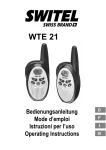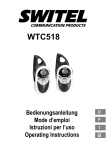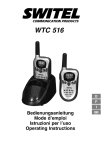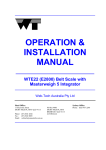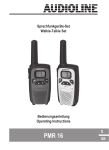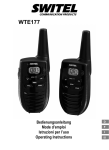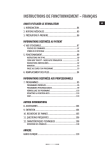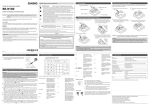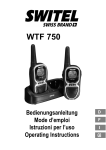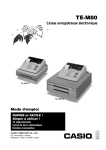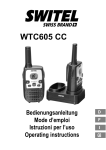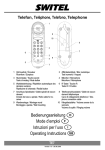Download Bedienungsanleitung Mode d'emploi Istruzioni per l'uso
Transcript
WTE22 Bedienungsanleitung Mode d’emploi Istruzioni per l’uso Operating Instructions Bedienungsanleitung . . . . . . . . . . . 3 Mode d’emploi . . . . . . . . . . . . . . 13 Istruzioni per l’uso . . . . . . . . . . . . 23 Operating Instructions . . . . . . . . . 33 Declaration of Conformity . . . . . . . 44 2 Sicherheitshinweise 1 LEERER MERKER Lesen Sie diese Bedienungsanleitung sorgfältig durch. 1 Sicherheitshinweise Bestimmungsgemäße Verwendung Diese Sprechfunkgeräte sind geeignet für die Kommunikation mit anderen Sprechfunkgeräten gleichen Standards. Jede andere Verwendung gilt als nicht bestimmungsgemäß. Eigenmächtige Veränderungen oder Umbauten sind nicht zulässig. Öffnen Sie die Geräte in keinem Fall selbst und führen Sie keine eigenen Reparaturversuche durch. Verwendungsbereich Vermeiden Sie Belastungen durch Rauch, Staub, Erschütterungen, Chemikalien, Feuchtigkeit, Hitze oder direkte Sonneneinstrahlung. Verwenden Sie die Funkgeräte nicht in explosionsgefährdeten Bereichen. Batterien Achtung: Werfen Sie Batterien nicht ins Feuer. Verwenden Sie nur Batterien des gleichen Typs! Achten Sie auf die richtige Polung! Bei verkehrter Polung der Batterien besteht Explosionsgefahr. Medizinische Geräte Achtung: Benutzen Sie die Funkgeräte nicht in der Nähe von medizinischen Geräten. Eine Beeinflussung kann nicht völlig ausgeschlossen werden. Funkgeräte können in Hörgeräten einen unangenehmen Brummton verursachen. 3 Sicherheitshinweise Entsorgung Sie sind gesetzlich zur sachgerechten Entsorgung von Gebrauchsgütern verpflichtet. Das nebenstehende Symbol bedeutet, dass elektrische und elektronische Altgeräte und Akkus getrennt vom Hausmüll zu entsorgen sind. Elektrische oder elektronische Geräte entsorgen Sie bei einer Sammelstelle eines geeigneten Entsorgungsträgers. Akkus entsorgen Sie beim batterievertreibenden Handel sowie bei zuständigen Sammelstellen, die entsprechende Behälter bereitstellen. Verpackungsmaterialien entsorgen Sie entsprechend den lokalen Vorschriften. 4 Funkgeräte in Betrieb nehmen 2 Funkgeräte in Betrieb nehmen Sicherheitshinweise Achtung: Lesen Sie vor der Inbetriebnahme unbedingt die Sicherheitshinweise in Kapitel 1. Verpackungsinhalt prüfen Zum Lieferumfang gehören: − zwei Funkgeräte mit Gürtelclip − eine Bedienungsanleitung Batterien einlegen Öffnen Sie das Batteriefach. Legen Sie die Batterien ein. Verwenden Sie nur Batterien des Typs AAA. Achten Sie auf die richtige Polung! Schließen Sie das Batteriefach. 5 Funkgeräte in Betrieb nehmen Batteriestand Sobald diese Anzeige im Display blinkt, müssen die Batterien gewechselt werden. Gürtelclip anbringen Schieben Sie den Gürtelclip von oben in die Führung, bis er hörbar einrastet. Um den Gürtelclip wieder zu entfernen, heben Sie die Befestigungslasche mit dem Fingernagel etwas an und schieben den Gürtelclip nach oben. 6 Bedienelemente 3 Bedienelemente Die Tasten Ihres Funkgeräts werden in dieser Bedienungsanleitung nachfolgend mit vereinheitlichten Symbolen dargestellt. Leichte Abweichungen der Tastensymbole Ihres Funkgeräts gegenüber den hier verwendeten Tastensymbolen sind daher möglich. Funkgerät 1 2 3 4 5 6 7 8 9 Antenne Display Rufton senden Lautstärke, Kanal abwärts Mikrofon Lautsprecher Lautstärke, Kanal aufwärts Ein / Aus, Kanaleinstellung PTT−Sprechtaste Display 1 2 3 4 5 1 2 9 3 8 7 4 5 6 1 2 3 Senden Kanal / Lautstärke Empfangen CH = Kanal LE = Lautstärke Batterien schwach 5 4 7 Wie bediene ich meine Funkgeräte? 4 Wie bediene ich meine Funkgeräte? Darstellungen und Schreibweisen P a, P b, P ð Abgebildete Taste drücken Abgebildete Taste gedrückt halten Abgebildete Taste loslassen In das Mikrofon sprechen Ein− / Ausschalten der Funkgeräte 2 aV Funkgerät einschalten Es erklingt ein Signal. Im Display wird der aktuell eingestellte Kanal angezeigt. aV Funkgerät ausschalten Lautstärkeregelung + oder , Lauter oder leiser Senden und Empfangen Senden 3 aPð Senden Halten Sie das Funkgerät ca. 5 bis 7 cm vom Mund entfernt und sprechen Sie mit normaler Lautstärke. Um mit anderen Teilnehmern zu sprechen, müssen alle Funkgeräte auf den gleichen Kanal eingestellt sein. Empfangen 4 b, P Empfangen Sie können keine Funksignale empfangen, wenn Sie die P−Taste gedrückt halten. 8 Wie bediene ich meine Funkgeräte? Bestätigungston (Roger Beep) Der Bestätigungston erklingt, wenn Sie die P−Taste loslassen. Dadurch wird Ihrem Gesprächspartner signalisiert, dass Ihre Übertragung beendet ist. Kanalwahl Einstellungsmodus aktivieren + oder ,, Kanal auswählen und bestätigen Kanal Frequenz (MHz) Kanal Frequenz (MHz) 1 2 3 4 446.00625 446.01875 446.03125 446.04375 5 6 7 8 446.05625 446.06875 446.08125 446.09375 Rufton senden Der Rufton macht andere Teilnehmer darauf aufmerksam, dass Sie ein Gespräch beginnen möchten. Voraussetzung dafür ist, dass die anderen Teilnehmer den gleichen Kanal verwenden. Rufton senden 9 Falls es Probleme gibt 5 Falls es Probleme gibt Service−Hotline Haben Sie Probleme mit Ihren Funkgeräten, kontrollieren Sie zuerst die folgenden Hinweise. Bei technischen Problemen können Sie sich an unsere Service−Hotline unter Tel. 0900 00 1675 innerhalb der Schweiz (Kosten Swisscom bei Drucklegung: CH 2.60/min) wenden. Bei Garantieansprüchen wenden Sie sich an Ihren Fachhändler. Die Garantiezeit beträgt 2 Jahre. Fragen und Antworten 10 Fragen Antworten Keine Funktion − Die Batterien sind nicht korrekt eingelegt − Die Batterien sind leer Senden nicht möglich − Drücken Sie die P−Taste vollständig, um zu senden − Ihr Kanal wird von anderen Teilnehmern benutzt Kein Empfang − Lassen Sie die P−Taste los, um zu empfangen − Die Lautstärke ist zu gering eingestellt − Sie befinden sich außerhalb des Empfangsbereichs, ändern Sie Ihre Position − Hindernisse wie Bäume und Gebäude haben einen negativen Einfluss auf die Reichweite Technische Eigenschaften 6 Technische Eigenschaften Technische Daten Merkmal Wert Ausgangsleistung 0.5 W Reichweite ca. 3 km − bei freier Sichtlinie Reichweite Hindernisse wie Bäume und Gebäude haben einen negativen Einfluss auf die Reichweite. Die folgende Skizze zeigt die zu erwartende Reichweite bei unterschiedlichen Bedingungen. Signalstärke 750 m 1,5 km ÎÎ ÎÎ ÎÎ ÎÎ ÎÎ ÎÎ ÎÎ Freie Sichtlinie Mittlere Bebauung Starke Bebauung ca. 3 km Konformitätserklärung Dieses Gerät erfüllt die Anforderungen der EU−Richtlinie: 1999/5/EG Richtlinie über Funkanlagen und Telekommunikationsendeinrichtungen und die gegenseitige Anerkennung ihrer Konformität. Die Konformität mit der o. a. Richtlinie wird durch das CE−Zeichen auf dem Gerät bestätigt. Für die komplette Konformitätserklärung nutzen Sie bitte den kostenlosen Download von unserer Website www.switel.com. 11 Pflegehinweise / Garantie 7 Pflegehinweise / Garantie Pflegehinweise Reinigen Sie die Gehäuseoberflächen mit einem weichen und fusselfreien Tuch. Verwenden Sie keine Reinigungsmittel oder Lösungsmittel. Garantie SWITEL − Geräte werden nach den modernsten Produktionsverfahren hergestellt und geprüft. Ausgesuchte Materialien und hoch entwickelte Technologien sorgen für einwandfreie Funktion und lange Lebensdauer. Die Garantie gilt nicht für die in den Produkten verwendeten Batterien, Akkus oder Akkupacks. Die Garantiezeit beträgt 24 Monate, gerechnet vom Tage des Kaufs. Innerhalb der Garantiezeit werden alle Mängel, die auf Material− oder Herstellungsfehler zurückzuführen sind, kostenlos beseitigt. Der Garantieanspruch erlischt bei Eingriffen durch den Käufer oder durch Dritte. Schäden, die durch unsachgemäße Behandlung oder Bedienung, natürliche Abnutzung, durch falsches Aufstellen oder Aufbewahren, durch unsachgemäßen Anschluss oder Installation sowie durch höhere Gewalt oder sonstige äußere Einflüsse entstehen, fallen nicht unter die Garantieleistung. Wir behalten uns vor, bei Reklamationen die defekten Teile auszubessern, zu ersetzen oder das Gerät auszutauschen. Ausgetauschte Teile oder ausgetauschte Geräte gehen in unser Eigentum über. Schadenersatzansprüche sind ausgeschlossen, soweit sie nicht auf Vorsatz oder grober Fahrlässigkeit des Herstellers beruhen. Sollte Ihr Gerät dennoch einen Defekt innerhalb der Garantiezeit aufweisen, wenden Sie sich bitte unter Vorlage Ihrer Kaufquittung ausschließlich an das Geschäft, in dem Sie Ihr SWITEL − Gerät gekauft haben. Alle Gewährleistungsansprüche nach diesen Bestimmungen sind ausschließlich gegenüber Ihrem Fachhändler geltend zu machen. Nach Ablauf von zwei Jahren nach Kauf und Übergabe unserer Produkte können Gewährleistungsrechte nicht mehr geltend gemacht werden. 12 Consignes de sécurité 1 Consignes de sécurité 5 Lisez très attentivement ce mode d’emploi. Utilisation conforme aux prescriptions Ces émetteurs−récepteurs conviennent pour la communication avec d’autres émetteurs−récepteurs de même standard. Toute autre utilisation est considérée comme non conforme. Des modifications ou changements effectués d’un propre gré ne sont pas autorisés. N’ouvrez en aucun cas les appareils et n’effectuez aucun essai de réparation vous−même. Zone d’utilisation Evitez toute nuisance par la fumée, la poussière, les chocs, les produits chimiques, l’humidité, la grande chaleur ou l’ensoleillement direct. Ne vous servez pas des émetteurs−récepteurs dans des endroits exposés aux explosions. Piles Attention : Ne jetez pas les piles rechargeables dans le feu. N’utilisez que des piles de même type ! Observez une polarisation correcte ! Risque d’explosion si la polarisation est inversée. Appareils médicaux Attention : N’utilisez pas ces émetteurs−récepteurs à proximité d’appareils médicaux. Leur influence sur ceux−ci ne pouvant pas être totalement exclue. Les émetteurs−récepteurs peuvent causer un bourdonnement désagréable dans les aides auditives. 13 Consignes de sécurité Élimination La loi vous oblige à éliminer de manière appropriée les biens de consommation. Le symbole placé ci−contre signifie que les anciens appareils électriques et électroniques ainsi que les piles rechargeables ne doivent pas être éliminés avec les ordures ménagères normales. Éliminez les appareils électriques ou électroniques dans le centre de collecte d’un organisme approprié d’évacuation des déchets. Éliminez les piles auprès d’un revendeur spécialisé ainsi que dans des centres de collecte qui tiennent à votre disposition les collecteurs appropriés correspondants. Éliminez les fournitures d’emballage conformément au règlement local. 14 Mise en service des émetteurs−récepteurs 2 Mise en service des émetteurs−récepteurs Consignes de sécurité Attention : Avant de mettre votre appareil en service, lisez impérativement les consignes de sécurité mentionnées au chapitre 1. Contrôler le contenu de l’emballage Les éléments suivants font partie du contenu : − deux émetteurs−récepteurs avec clip de ceinture − un mode d’emploi Placer les piles Ouvrez le compartiment à piles. Placez−y les piles. N’utilisez que des piles de type AAA. Observez une polarisation correcte ! Fermez le compartiment à piles. 15 Mise en service des émetteurs−récepteurs Niveau des piles Dès que cet affichage clignote sur l’écran, vous devez changer les piles. Poser le clip de ceinture Introduisez le clip de ceinture par le haut dans le guidage jusqu’à ce qu’il s’enclenche. Pour l’enlever, soulevez légèrement la languette de fixation avec l’ongle et poussez le clip vers le haut. 16 Eléments de manipulation 3 Eléments de manipulation Dans ce mode d’emploi, les touches de votre émetteur−récepteur seront représentées par la suite par des icônes standardisées. De ce fait, il peut y avoir de légères différences entre les icônes des touches de votre émetteur−récepteur et celles utilisées ici. Èmetteur-récepteur 1 2 3 4 5 6 7 8 9 Antenne Écran Émission du signal d’appel Volume sonore, canal décroissant 9 Microphone Haut−parleur 8 Volume sonore, 7 canal croissant Éteint / Allumé, Réglage du canal Touche de conversation PTT (press to talk) Écran 1 2 3 4 5 6 1 1 2 3 4 5 2 3 Émission Canal / Volume sonore Réception CH = Canal LE = Volume sonore Piles faibles 5 4 17 Comment vous servir de vos émetteurs−récepteurs ? 4 Comment vous servir de vos émetteurs−récepteurs ? Représentations et notations P a, P b, P ð Appuyer sur la touche représentée Maintenir appuyée la touche représentée Relâcher la touche représentée Parler dans le microphone Allumer / éteindre les émetteurs−récepteurs 6 aV Brancher l’émetteur−récepteur Un signal sonore se fait entendre. Le canal actuellement programmé est affiché à l’écran. aV Débrancher l’émetteur−récepteur Réglage du volume sonore + ou , Plus fort ou plus faible Émettre et recevoir Émettre 7 aPð Émettre Tenez l’émetteur−récepteur à environ 5 à 7 cm de votre bouche et parlez avec un volume sonore normal. Pour parler avec d’autres correspondants, tous les appareils doivent être réglés sur le même canal. Recevoir 8 b, P Recevoir Vous ne pouvez pas recevoir de signaux radio si vous maintenez la touche P appuyée. 18 Comment vous servir de vos émetteurs−récepteurs ? Signal de confirmation (Roger Beep) Le signal de confirmation retentit quand vous relâchez la toucheP. Cela signale à votre correspondant que votre transmission est terminée. Choix du canal Activer le mode de réglage + ou ,, Sélectionner le canal et confirmer Canal Fréquence (MHz) Canal Fréquence (MHz) 1 2 3 4 446.00625 446.01875 446.03125 446.04375 5 6 7 8 446.05625 446.06875 446.08125 446.09375 Émettre un signal d’appel Le signal d’appel fait remarquer à d’autres correspondants que vous désirez entamer une conversation. À condition toutefois que les autres correspondants utilisent le même canal. Émettre le signal d’appel 19 En cas de problèmes 5 En cas de problèmes Ligne directe de service Si vous avez des problèmes avec vos émetteurs−récepteurs, contrôlez d’abord les remarques suivantes. En cas de problèmes techniques, vous pouvez vous adresser à notre ligne directe de service en Suisse en appelant le numéro de tél. 0900 00 1675 (frais Swisscom à la date d’impression de ce manuel : CH 2.60/min). Si vous jouissez de droits de garantie, adressez− vous à votre revendeur. La durée de la garantie est de 2 ans. Questions et réponses 20 Questions Réponses Pas de fonction − Les piles ne sont pas placées correctement − Les piles sont vides Émission pas possible − Appuyez complètement sur la touche P pour émettre − Votre canal est utilisé par un autre correspondant Pas de réception − Relâchez la touche P pour recevoir − Le volume sonore est réglé trop faiblement − Vous vous trouvez en dehors de la zone desservie, modifiez votre position − Des obstacles, comme des arbres ou des bâtiments, exercent une influence négative sur la portée Caractéristiques techniques 6 Caractéristiques techniques Données techniques Caractéristique Valeur Puissance de sortie 0,5 W Portée env. 3 km − si ligne visuelle libre Portée Des obstacles, comme des arbres ou des bâtiments, exercent une influence négative sur la portée. Le croquis suivant indique la portée prévisible en fonction des différentes conditions. Intensité du signal 750 m ÎÎ ÎÎ ÎÎ ÎÎ ÎÎ ÎÎ Ligne visuelle libre Moyenne densité de constructions Forte densité de constructions 1,5 km env. 3 km Déclaration de conformité Cet appareil répond aux exigences des directives de l’union européenne (UE) : Directive 1999/5/CE sur les installations de radio et de télécommunication et la reconnaissance réciproque de leur conformité. La conformité avec la directive mentionnée ci−dessus est confirmée par le symbole CE placé sur l’appareil. Pour obtenir la déclaration de conformité intégrale, veuillez vous servir du téléchargement gratuit de notre site Internet www.switel.com. 21 Remarques d’entretien / Garantie 7 Remarques d’entretien / Garantie Remarques d’entretien Nettoyez les surfaces du boîtier avec un chiffon doux et non pelucheux. N’utilisez pas de produits d’entretien ou de solvants. Garantie Les appareils SWITEL sont fabriqués selon les procédés les plus modernes et contrôlés. Des matériaux sélectionnés et des technologies de pointe ont pour effet un fonctionnement irréprochable et une longue durée de vie. La garantie n’est pas valable pour les piles, les piles rechargeables ou les packs de piles rechargeables utilisés dans les produits. La durée de la garantie est de 24 mois, à partir de la date d’achat. Pendant la durée de la garantie, tous les défauts dus à des vices de matériel ou de fabrication seront éliminés gratuitement. Le droit à la garantie expire en cas d’intervention de l’acheteur ou de tiers. Les dommages provenant d’un maniement ou d’une manipulation incorrects, d’une usure naturelle, d’une mauvaise mise en place ou d’une mauvaise conservation, d’un raccordement ou d’une installation incorrects ainsi que d’un cas de force majeure ou autres influences extérieures sont exclus de la garantie. En cas de réclamations, nous nous réservons le droit de réparer, de remplacer les pièces défectueuses ou d’échanger l’appareil. Les composants remplacés ou les appareils échangés deviennent notre propriété. Les demandes de dommages et intérêts sont exclues tant qu’elles ne reposent pas sur l’intention ou une négligence grossière du fabricant. Si votre appareil présentait malgré tout une défectuosité pendant la période de garantie, veuillez vous adressez, muni de la quittance d’achat, exclusivement au magasin où vous avez acheté votre appareil SWITEL. Tous les droits de garantie basés sur ces dispositions ne peuvent être revendiqués qu’auprès de votre revendeur. Deux ans après l’achat et la remise de nos produits, il n’est plus possible de faire valoir les droits à la garantie. 22 Indicazioni di sicurezza 1 Indicazioni di sicurezza 9 Leggere attentamente le presenti istruzioni per l’uso. Impiego conforme agli usi previsti Questi ricetrasmettitori si prestano alla comunicazione con altri apparecchi ricetrasmittenti aventi lo stesso standard. Qualsiasi altro impiego è considerato come non conforme agli usi previsti. Non sono consentite modifiche o trasformazioni non autorizzate. Non aprire per nessuna ragione gli apparecchi autonomamente ed evitare di compiere riparazioni di propria iniziativa. Ambito di impiego Evitare un’esposizione a fumo, polvere, vibrazioni, sostanze chimiche, umidità, calore e raggi solari diretti. Non utilizzare i radiotrasmettitori in aree esposte al rischio di deflagrazione. Batterie Attenzione: Non gettare le batterie nel fuoco. Utilizzare solo batterie dello stesso tipo. Osservare la corretta polarità! Pericolo di esplosione delle batterie in caso di errata polarità. Apparecchiature mediche Attenzione: Evitare di utilizzare i radiotrasmettitori in vicinanza di apparecchiature mediche. Non è infatti possibile escludere il rischio di possibili interferenze. Radiotrasmettitori possono causare un fastidioso ronzio in apparecchi acustici. 23 Indicazioni di sicurezza Smaltimento Sussiste l’obbligo legislativo al corretto smaltimento di beni di consumo. Il simbolo raffigurato qui a lato indica che apparecchi elettrici ed elettronici usati e batterie esauste non sono da smaltire assieme ai normali rifiuti domestici. Procedere allo smaltimento di apparecchi elettrici o elettronici presso un centro di raccolta incaricato con lo smaltimento conforme. Consegnare batterie ed accumulatori per lo smaltimento presso rivenditori al dettaglio di batterie o centri di raccolta che mettono a disposizione appositi contenitori. Smaltire confezioni ed imballaggi in base a quanto indicato dalle norme in vigore a livello locale. 24 Mettere in funzione i radiotrasmettitori 2 Mettere in funzione i radiotrasmettitori Indicazioni di sicurezza Attenzione: Prima della messa in funzione, leggere attentamente le indicazioni di sicurezza riportate al capitolo 1. Verificare il contenuto della confezione La confezione comprende: − due radiotrasmettitori con gancio per cintura − un manuale di istruzioni per l’uso Inserire le batterie Aprire il vano batterie. Inserire le batterie. Utilizzare solo batterie di tipo AAA. Osservare la corretta polarità! Chiudere il vano batterie. 25 Mettere in funzione i radiotrasmettitori Stato di carica delle batterie Non appena le visualizzazioni sul display lampeggiano occorre sostituire le batterie. Montare il gancio per cintura Introdurre il gancio per cintura dall’alto nella guida fino a farlo scattare in posizione. Per rimuovere nuovamente il gancio per cintura, sollevare leggermente la linguetta di fissaggio con l’unghia del dito spingendo il gancio per cintura verso sopra. 26 Elementi di comando 3 Elementi di comando I tasti del radiotrasmettitore riportati nel presente manuale d’istruzioni per l’uso sono raffigurati sotto forma di simboli uniformi. Sono pertanto possibili lievi scostamenti dei simboli dei tasti sul radiotrasmettitore rispetto ai simboli qui raffigurati. Radiotrasmettitore 1 2 3 4 5 6 7 8 9 Antenna Display Invio segnale di chiamata Volume, canale in basso 9 Microfono Altoparlante 8 Volume, 7 canale in alto ON / OFF, impostazione canale Tasto di conversazione PTT Display 1 2 3 4 5 1 2 3 4 5 6 1 2 3 Trasmettere Canale / Volume Ricevere CH = Canale LE = Volume Batteria quasi scarica 5 4 27 Come funzionano i miei radiotrasmettitori? 4 Come funzionano i miei radiotrasmettitori? Rappresentazioni e modi di scrittura P a, P b, P ð Premere il tasto raffigurato Tenere premuto il tasto raffigurato Rilasciare il tasto raffigurato Parlare rivolti verso il microfono Attivare / Disattivare i radiotrasmettitori 10 aV Attivare il radiotrasmettitore Si avverte un segnale acustico. Il canale attualmente impostato è visualizzato sul display. aV Disattivare il radiotrasmettitore Regolazione del volume +o, Volume più alto o più basso Trasmettere e ricevere Trasmettere 11 aPð Trasmettere Mantenere con il radiotrasmettitore una distanza di ca. 5 − 7 cm dalla bocca e parlare con voce normale. Per poter comunicare con altri interlocutori, tutti i radiotrasmettitori devono essere impostati sullo stesso canale. Ricevere 12 b, P Ricevere Non è possibile ricevere alcun segnale radio se si tiene premuto il tasto P. 28 Come funzionano i miei radiotrasmettitori? Segnale acustico di conferma (Roger Beep) Il segnale acustico di conferma risuona rilasciando il tasto P. In tal modo al proprio partner di chiamata si segnala la conclusione della trasmissione. Selezione del canale Attivare la modalità di impostazione + o ,, Selezionare il canale e confermare Canale Frequenza (MHz) Canale Frequenza (MHz) 1 2 3 4 446.00625 446.01875 446.03125 446.04375 5 6 7 8 446.05625 446.06875 446.08125 446.09375 Trasmettere il segnale di chiamata Il segnale di chiamata richiama l’attenzione degli altri interlocutori indicando che il chiamante desidera avviare una conversazione. A tal fine è necessario che gli altri interlocutori utilizzino lo stesso canale. Trasmettere un segnale di chiamata 29 In presenza di problemi 5 In presenza di problemi Linea di assistenza tecnica In presenza di problemi con i radiotrasmettitori, seguire le indicazioni riportate qui di seguito. In caso di problemi tecnici è possibile rivolgersi alla nostra linea di assistenza tecnica chiamando al numero 0900 00 1675 valido per la Svizzera (spese da rete Swisscom alla data di stampa: CH 2.60/min). In caso di reclami entro il periodo di garanzia, rivolgersi al rivenditore autorizzato. Il periodo di garanzia ricopre 2 anni. Domande e risposte 30 Domande Risposte Nessuna funzione − Le batterie non sono state inserite correttamente − Le batterie sono scariche Trasmissione non è possibile − Premere completamente il tasto P per trasmettere − Il canale è utilizzato da un altro interlocutore Nessuna ricezione − Rilasciare il tasto P per ricevere − Il volume è impostato ad un livello troppo basso − Si è al di fuori del campo di ricezione, modificare la propria posizione − Eventuali ostacoli come alberi ed edifici hanno un influsso negativo sulla portata Specifiche tecniche 6 Specifiche tecniche Specifiche tecniche Caratteristica Valore Potenza di uscita 0.5 W Portata ca. 3 km − con linea di mira libera Portata Eventuali ostacoli come alberi ed edifici hanno un influsso negativo sulla portata. Il seguente schema indica la portata prevista tenuto conto di differenti e possibili condizioni. Intensità del segnale 750 m 1,5 km ÎÎ ÎÎ ÎÎ ÎÎ ÎÎ ÎÎ ÎÎ Linea di mira libera Media edificazione Forte edificazione ca. 3 km Dichiarazione di conformità Questo apparecchio risponde a quanto disposto dalla Direttiva UE: 1999/5/CE concernente le apparecchiature radio, le apparecchiature terminali di telecomunicazioni e il reciproco riconoscimento della loro conformità. La conformità con la Direttiva di cui sopra viene confermata dal marchio CE applicato sull’apparecchio. Per la dichiarazione di conformità completa si prega di voler usufruire del servizio gratuito di download dal nostro sito Internet www.switel.com. 31 Consigli per la cura / Garanzia 7 Consigli per la cura / Garanzia Consigli per la cura Pulire le superfici degli apparecchi con un panno morbido e antipelucchi. Non utilizzare mai detergenti o solventi. Garanzia Gli apparecchi SWITEL sono costruiti e collaudati in osservanza dei processi di produzione più moderni. L’impiego di materiali selezionati e tecnologie altamente sviluppate sono garanti di una perfetta funzionalità e lunga durata in vita. La garanzia non si estende a batterie, accumulatori o batterie ricaricabili utilizzati all’interno degli apparecchi. Il periodo di garanzia ricopre 24 mesi a partire dalla data di acquisto. Entro il periodo di garanzia si procederà all’eliminazione gratuita di tutti i guasti dovuti a difetti di materiale o produzione. Il diritto di garanzia cessa in caso di interventi da parte dell’acquirente o di terzi. Danni derivanti da un impiego o esercizio non conforme agli usi previsti, a naturale usura, a errato montaggio o errata conservazione, a collegamento o installazione impropri, dovuti a forza maggiore o ad altri influssi esterni non sono coperti da garanzia. In qualità di produttore ci riserviamo il diritto, in caso di reclami, di riparare o sostituire le parti difettose o di rimpiazzare l’apparecchio. Parti o apparecchi sostituiti passano di nostra proprietà. Sono esclusi diritti di risarcimento per danni qualora non siano dovuti a intenzione o colpa grave del costruttore. Nel caso in cui il presente apparecchio dovesse ciò nonostante presentare un difetto durante il periodo di garanzia, si prega di rivolgersi esclusivamente al negozio di rivendita dell’apparecchio SWITEL assieme al relativo scontrino di acquisto. In base alle presenti disposizioni, tutti i diritti di garanzia dovranno essere fatti valere esclusivamente nei confronti del rivenditore autorizzato. Decorso il termine di due anni dalla data di acquisto e consegna dei nostri prodotti non sarà più possibile fare valere alcun diritto di garanzia. 32 Safety Information 1 Safety Information 13 Please read this operating instruction manual thoroughly. Intended use These walkie−talkies have been conceived for communication with other walkie−talkies complying to the same standards. Any other use is considered unintended use. Unauthorised modification or reconstruction is not permitted. Under no circumstances open the devices or complete any repair work yourself. Ambient conditions Prevent excessive exposure to smoke, dust, vibration, chemicals, moisture, heat and direct sunlight. Do not use the walkie−talkies in potentially explosive areas. Batteries Attention: Never throw batteries into a fire. Only use batteries of the same type. Pay attention to the correct polarity. Incorrect polarity of the batteries represents a risk of explosion. Medical equipment Attention: Never use the walkie−talkies in the vicinity of medical equipment. Effects on such equipment cannot be fully ruled out. Walkie−talkies can cause an unpleasant humming sound in hearing aids. 33 Safety Information Disposal You are obliged to dispose of consumable goods according to legal requirements. The adjacent symbol indicates that electrical and electronic apparatus and batteries no longer required must be disposed of separate from domestic waste. Electrical and electronic devices must be disposed of at suitable collection points provided by the public waste authorities. Batteries must be disposed of at the point of sale or at the appropriate collection points provided by the public waste authorities. Packaging materials must be disposed of according to local regulations. 34 Preparing the Walkie−Talkies for Use 2 Preparing the Walkie−Talkies for Use Safety information Attention: It is essential to read the Safety Information in Chapter 1 before starting up. Checking the package contents The package contains: − two walkie−talkies with belt clip − an operating manual Inserting the batteries Open the battery compartment. Insert the batteries. Only use AAA type batteries. Pay attention to correct polarity. Close the battery compartment. 35 Preparing the Walkie−Talkies for Use Battery status The batteries must be replaced as soon as the above icon starts to flash in the display. Attaching the belt clip Slide the belt clip in the guide from the top until it audibly snaps into place. To detach the belt clip, prize the fastening tab up a little with your fingernail and slide the belt clip upwards. 36 Operating Elements 3 Operating Elements The buttons in this operating manual are subsequently depicted with a uniform contour. Therefore, slight deviations in the appearance of the symbols on the walkie−talkie buttons compared to those depicted here are possible. Walkie-talkie 1 2 3 4 5 6 7 8 9 Antenna Display Transmit ringing tones Volume, Channel, scroll down Microphone Loudspeaker Volume, Channel, scroll up On / Off, Channel setting PTT − Talk button Display 1 2 3 4 5 1 2 9 3 8 7 4 5 6 1 2 3 Transmitting Channel / Volume Receiving CH = Channel LE = Volume Weak battery 5 4 37 Operating the Walkie−Talkies 4 Operating the Walkie−Talkies Display and notation of operating sequences P a, P b, P ð Press the button depicted Press and hold the button depicted Release the button displayed Speak into the microphone Switching the walkie−talkie on/off 14 aV Switch the walkie−talkie on An acoustic signal is issued. The current channel setting appears in the display. aV Switch the walkie−talkie off Volume control + or , Raise or lower the volume Transmitting and receiving Transmitting 15 aPð Transmit Hold the walkie−talkie approx. 5 to 7 cm from your mouth and speak at a normal volume. In order to talk to other subscribers, the respective walkie−talkies must be set to the same channel. Receiving 16 b, P Receive Radio signals cannot be received when the P button is being pressed. 38 Operating the Walkie−Talkies Confirmation signal (Roger beep) The confirmation signal is issued on releasing the P button. This signals to the caller that you have ended transmission. Selecting a channel Activate programming mode + or ,, Select the channel and confirm it Channel Frequency (MHz) Channel Frequency (MHz) 1 2 3 4 446.00625 446.01875 446.03125 446.04375 5 6 7 8 446.05625 446.06875 446.08125 446.09375 Transmitting a ringing tone The ringing tones indicate to other subscribers that you want to talk to them. A condition for this is that the other subscribers are using the same channel. Transmit the ringing tone 39 In Case of Problems 5 In Case of Problems Service hotline If you encounter problems with the walkie−talkies, please check the following information first. In the case of technical problems, please contact our Service Hotline under tel. 0900 00 1675 within Switzerland (costs via Swisscom at time of going to print: CH 2.60/min). In the case of claims under the terms of guarantee, please contact your sales outlet. There is a 2 year period of guarantee. Problems and solutions 40 Problems Solutions Equipment does not function − The batteries are not inserted correctly − The batteries are empty Transmission not possible − Press the P button in fully in order to transmit − The channel is being used by other subscribers No reception − Release the P button in order to receive − The volume is set too low − You are outside the range of reception, change your position − Obstructions such as trees and buildings impair the range Technical Properties 6 Technical Properties Technical data Feature Value Output power 0.5 W Range Approx. 3 km in open space Range Obstructions such as trees and buildings impair the range. The following diagram indicates the range which can be expected under different conditions. Signal strength 750 m 1.5 km ÎÎ ÎÎ ÎÎ ÎÎ ÎÎ ÎÎ ÎÎ Clear view Normal building development Dense building development Approx. 3 km Declaration of Conformity This device fulfils the requirements stipulated in the EU directive: 1999/5/EU directive on radio equipment and telecommunications terminal equipment and the mutual recognition of their conformity. Conformity with the above mentioned directive is confirmed by the CE symbol on the device. To view the complete Declaration of Conformity, please refer to the free download available on our web site at www.switel.com. 41 Maintenance / Guarantee 7 Maintenance / Guarantee Maintenance Clean the housing surfaces with a soft, fluff−free cloth. Never use cleaning agents or solvents. Guarantee SWITEL equipment is produced and tested according to the latest production methods. The implementation of carefully chosen materials and highly developed technologies ensure trouble−free functioning and a long service life. The terms of guarantee do not apply to the batteries or power packs used in the products. The period of guarantee is 24 months from the date of purchase. All deficiencies related to material or manufacturing errors within the period of guarantee will be redressed free of charge. Rights to claims under the terms of guarantee are annulled following tampering by the purchaser or third parties. Damage caused as the result of improper handling or operation, normal wear and tear, incorrect positioning or storage, improper connection or installation or Acts of God and other external influences are excluded from the terms of guarantee. In the case of complaints, we reserve the right to repair defect parts, replace them or replace the entire device. Replaced parts or devices become our property. Rights to compensation in the case of damage are excluded where there is no evidence of intent or gross negligence by the manufacturer. If your device shows signs of defect during the period of guarantee, please return it to the sales outlet in which you purchased the SWITEL device together with the purchase receipt. All claims under the terms of guarantee in accordance with this agreement can only be asserted at the sales outlet. No claims under the terms of guarantee can be asserted after a period of two years from the date of purchase and hand−over of the product. 42 Notes Notes 43 Declaration of Conformity 17 Diese Anlage entspricht der europäischen R&TTE Richtlinie. Für die komplette Konformitätserklärung nutzen Sie bitte den kostenlosen Download von unserer Website www.switel.com. Cet équipement est conforme à la directive européenne R&TTE. Pour obtenir la déclaration de conformité intégrale, veuillez vous servir du téléchargement gratuit de notre site Internet www.switel.com. Quest’apparecchiatura è conforme alla direttiva europea R&TTE. Per la dichiarazione di conformità completa si prega di voler usufruire del servizio gratuito di download dal nostro sito Internet www.switel.com. This equipment complies with the European R&TTE directive. To view the complete Declaration of Conformity, please refer to the free download available at our web site: www.switel.com. Service Hotline Bei technischen Problemen können Sie sich an unsere Service−Hotline unter Tel. 0900 00 1675 innerhalb der Schweiz (Kosten Swisscom bei Drucklegung: CHF 2.60/min) wenden. S’il s’agit de problèmes techniques, vous pouvez vous adresser à notre hotline de service en Suisse en appelant le numéro 0900 00 1675 (frais Swisscom à la date d’impression de ce manuel : CHF 2.60/min). In caso di problemi tecnici è possibile rivolgersi alla nostra hotline di assistenza tecnica chiamando al numero 0900 00 1675 valido per la Svizzera (spese da rete Swisscom alla data di stampa: CHF 2.60 / min). In the event of technical problems, you can contact our hotline service, Tel. 0900 00 1675 within Switzerland (cost via Swisscom at time of going to print: CHF 2.60/min). Version 1.0 − 14.04.2010
This document in other languages
- français: SWITEL WTE22
- Deutsch: SWITEL WTE22
- italiano: SWITEL WTE22












































